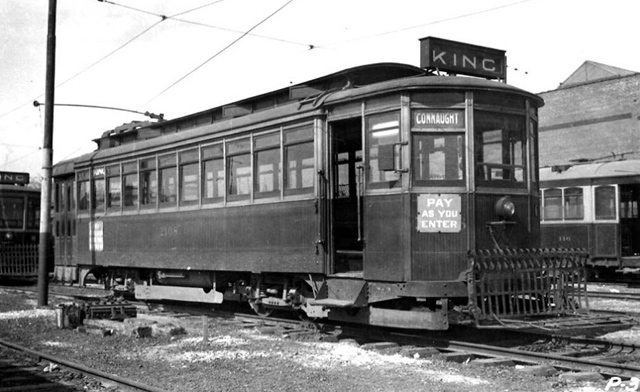Dates of operation 1891–1921 Locale Toronto | Headquarters Toronto, Canada | |
 | ||
Track gauge 4 ft 10 ⁄8 in (1,495 mm) Successor | ||
Toronto railway company 327
The Toronto Railway Company (TRC) was the first operator of horseless streetcars in Toronto.
Contents
Formed by a partnership between James Ross and William Mackenzie, a 30-year franchise was granted in 1891 to modernize transit operations after a previous 30 year franchise that saw horse car service from the Toronto Street Railways (TSR). At the end of the TSR franchise, the city ran the railway for eight months, but ended up granting another 30-year franchise to a private operator, the TRC. The first electric car ran on August 15, 1892, and the last horse car ran on August 31, 1894, to meet franchise requirements. There came to be problems with interpretation of the franchise terms, for the city. A series of annexations, especially in 1908–12, significantly extended the city limits to include such areas as Dovercourt, Earlscourt, East Toronto, Midway (formerly between Toronto and East Toronto), North Toronto, and West Toronto. After many attempts to force the TRC to serve these areas, the city created its own street railway operation, the Toronto Civic Railways to do so, and built several routes. Repeated court battles did force the TRC to build new cars, but they were of old design. When the TRC franchise ended in 1921, the Toronto Transportation Commission was created, combining with the city-operated Toronto Civic Railways lines.
Subway
The TRC had a proposal for a subway-like line under Queen Street using streetcars, but the idea died after a city vote rejected the proposal in 1910.
The proposed system consisted of three underground routes: streetcar tunnels under Queen and Bloor Streets, and a rapid transit subway along Yonge Street. These routes would have connected with surface streetcar routes and radial railways.
Routes
Roster
The TRC streetcars were made of wood and after 1906 the basic design of their cars did not change. All but ten of the TRC cars were built in-house at their car works at Front and Frederick Streets.
Because of a narrow devilstrip (distance between tracks), later cars were built with a taper to the roof on the passing side, and car bodies were offset to the right by four inches. The idea was to build a wider car and still safely pass another car traveling in the opposite direction.
Very early on, in 1894 the TRC decided on single-end operation. Many of the early streetcars were 'open' cars, where one entered from either side of the car, but with single-ended operation, only the curb 'near' side of the car was left open. In other Canadian cities (e.g., London, Montreal), this form of open car became common. Open cars carried huge loads of people, because there were no aisles.
In warm weather, people loved open cars. When it rained, there were side curtains that one could unroll from the roof to keep one dry. When it was cold, open cars were not so attractive, so the TSR developed a 'convertible car' in which the nearside of the car could be removed in the spring, and re-connected in the fall, thus changing from an open car to a closed car.
The TRC also had a subsidiary company, the Convertible Car Company of Toronto, that built cars for systems in Mexico, South America, and Western Canada. Several large interurban cars were turned out for the Toronto and York Radial Railway.
The TRC never had a steel car, but by 1921, the city-operated Toronto Civic Railways had both single and double truck steel cars, including the standardized Birney Car.
Some used TRC cars were sold to Winnipeg Electric Street Railway Company and Winnipeg Electric Railway Company.
Other Facilities
Demise
After losing routes to the TTC in 1921, TRC ceased to exist when it was legally dissolved in 1930.
